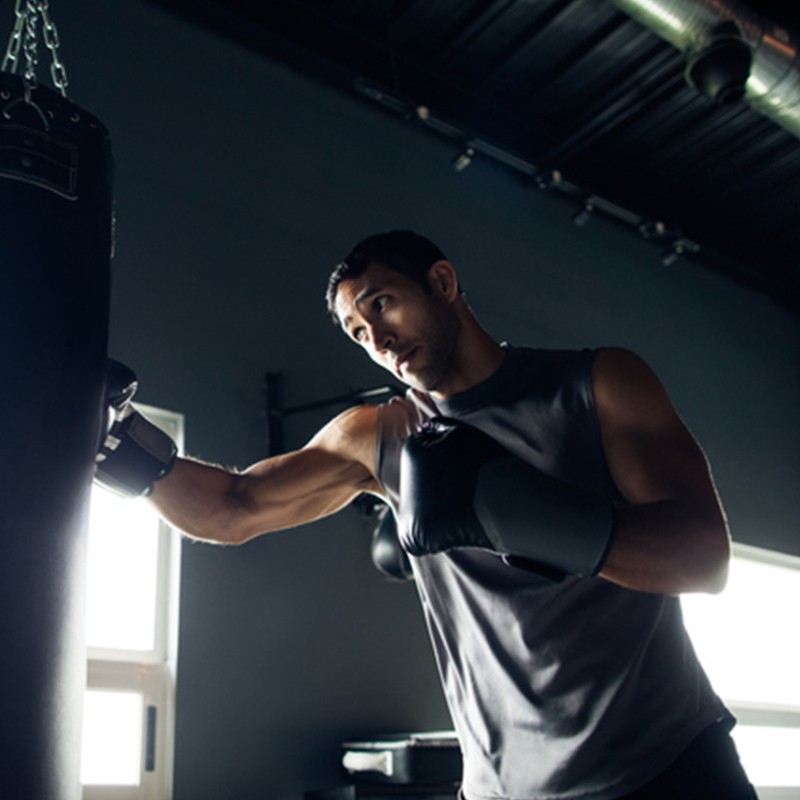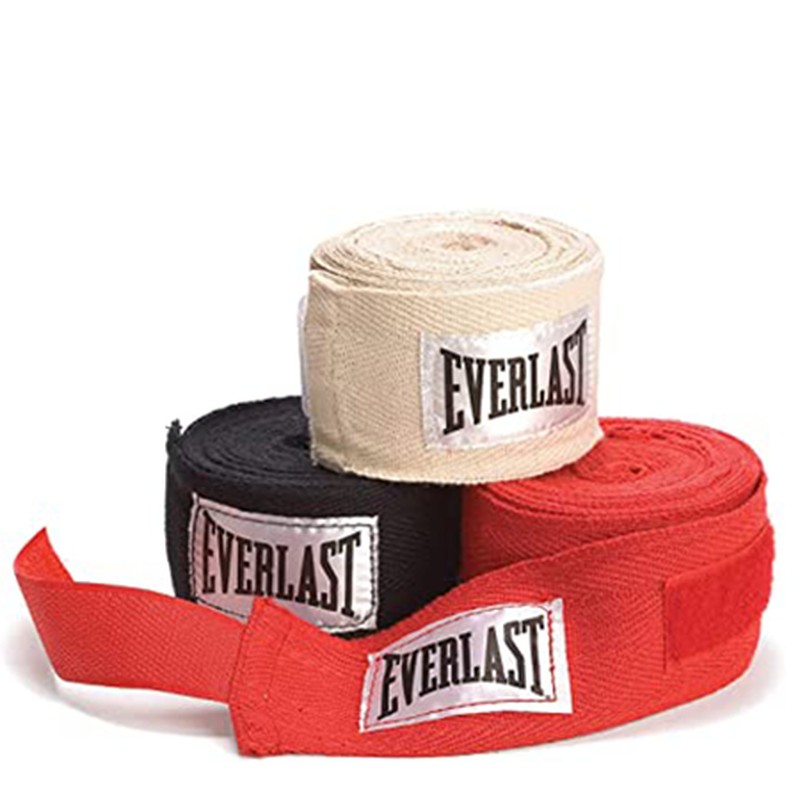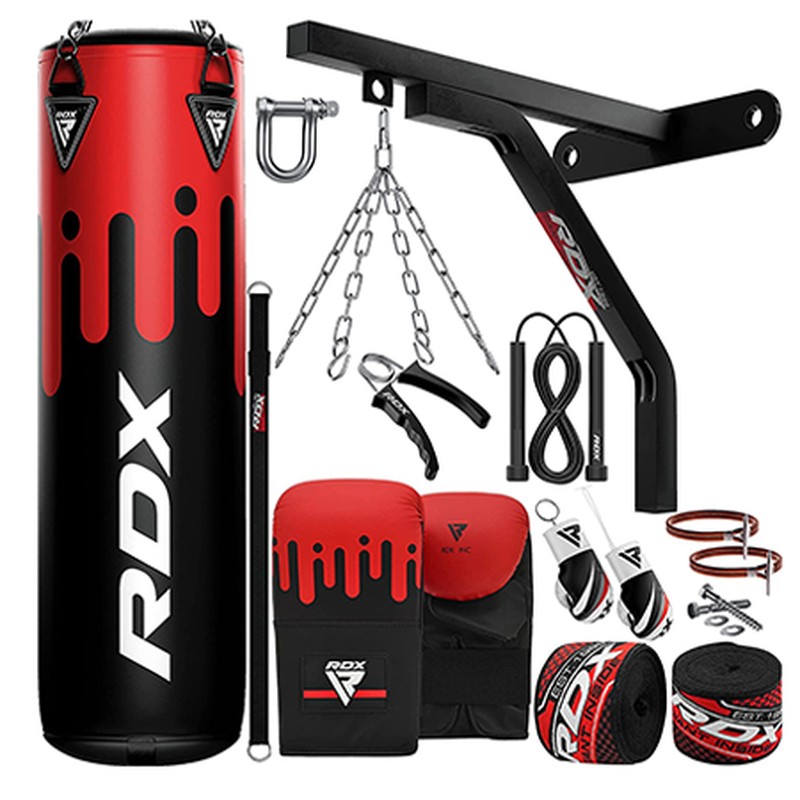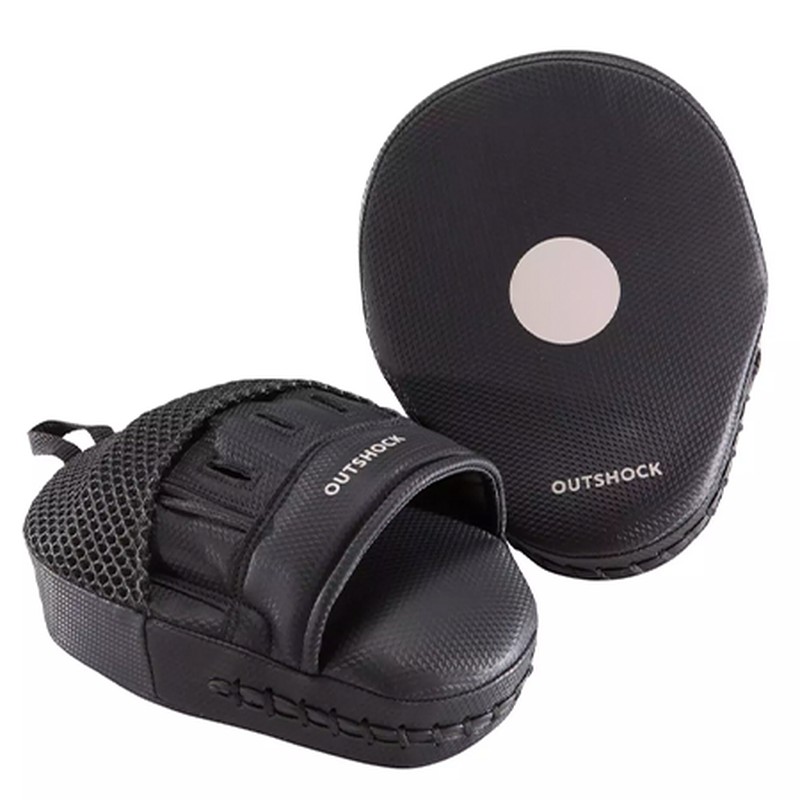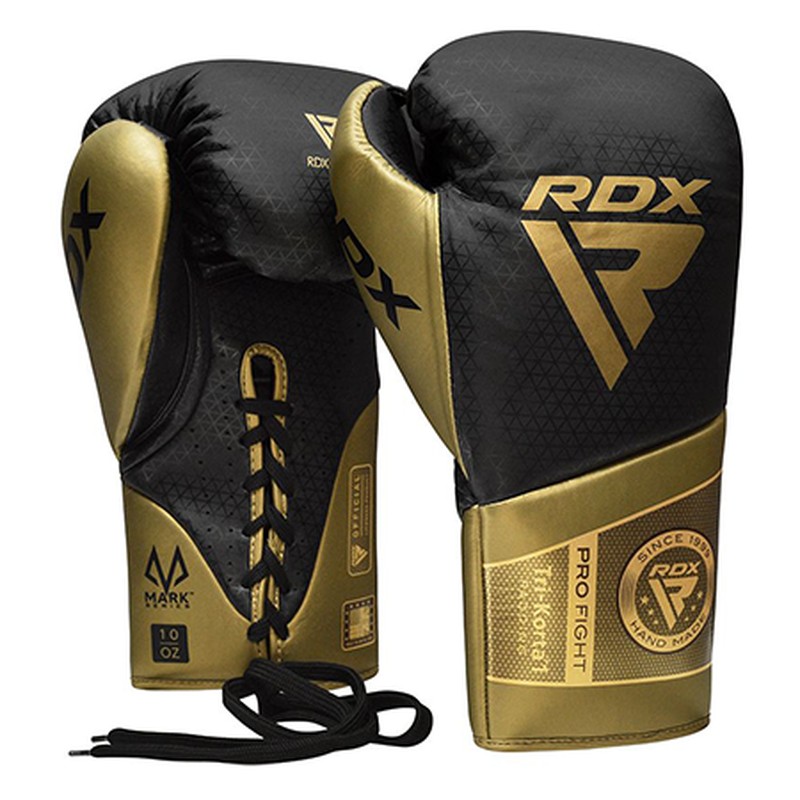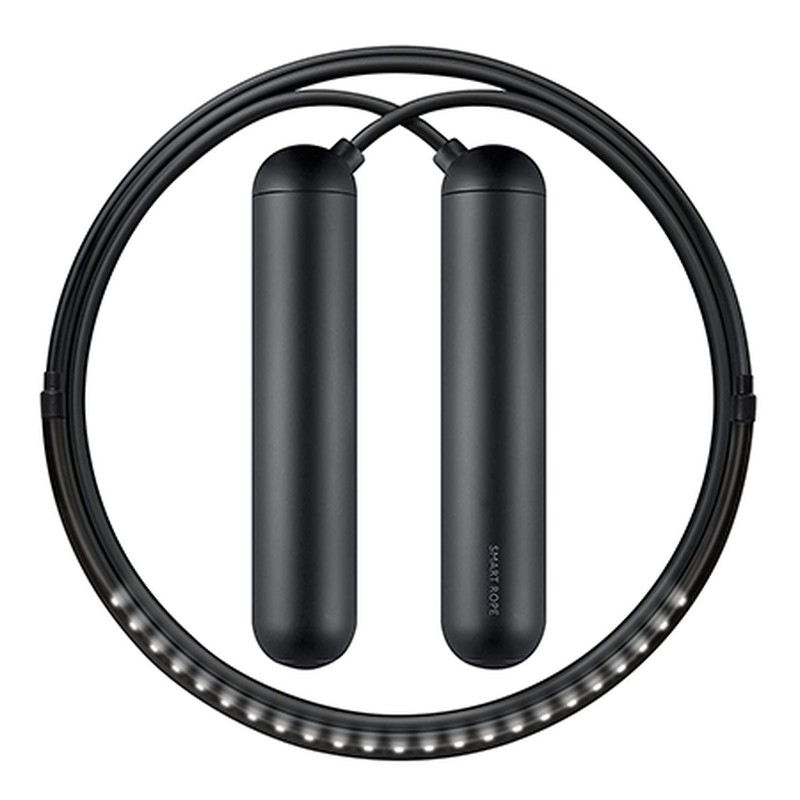Boxing 101: What To Know & Where To Go
The Benefits Are Endless
Boxing is one of the most accessible, heart rate-rising, strength-building workouts you can do, says Sammy Mcness, trainer at BXR. “Boxing is a full-body workout that builds explosive strength and tremendous stamina. It will also challenge you mentally through having to focus on different combinations of punches, footwork and technique.” As well as targeting your traps, shoulders, biceps, triceps, chest, quads, glutes and abs in one fell swoop, it’ll also build mental strength.
“Discipline is the number one trait of a great boxer,” Shane Collins, founder of KOBOX, tells SLMan. “Agreed, it’s also a fun workout – there isn’t anyone who doesn’t like to hit something that doesn’t hit back – but any decent boxer has incredible discipline, and that’s the best skill you can learn in the sport, at any level. Boxing can sometimes get a bad rap, especially when compared to other combat sports like karate and taekwondo, but the benefits are endless.” And ultimately, if you’re having a bad day, there’s nothing better than taking it all out on a heavy bag.
There Are Six Punches To Master
Even if you’ve never boxed before, chances are you’ll know there’s a number of basic punches. “I like to number them from one to six,” says Shane. “One and two are the jab and the cross – these are both straight punches. The jab (one) is thrown with your front hand and is one of the weaker punches, often used to find your range and create openings for the more powerful punches. The cross (two) is thrown straight with your rear hand and is more powerful than the jab. Punches three and four are called hooks. Hooks are big power punches that are thrown to attack your opponent or the bag from the side. To do them well, you’ll need to focus on rotating your body to generate the necessary power. The final punches – five and six – are uppercuts. You may have seen Mike Tyson taking people out by ducking low before delivering a huge upwards punch to the chin for the knockout. Your legs are the key drivers of these punches – that’s where the power comes from.”
When it comes to perfecting those techniques, practice makes perfect, but so does patience. “Ten punches, thrown well with good technique will have greater impact on your body than throwing 100 messy punches,” says Shane. “Slow down and focus on technique. You’ll recruit more muscles, your training will intensify, and your results will follow.”
It’s All About The Footwork
“A good stance is the difference between being a great boxer and an average one,” says Jay Revan, boxing and conditioning coach at My Manor London. “Mastering your boxing stance should always be followed up by having great footwork. Your footwork will determine your speed, balance and punching power. Once you have both your stance and footwork in place, the ability to throw a punch with correct technique is a skill all boxers must have. This will come from consistent training and repetition of each of the basic punches, drilling them with shadow boxing, pad work, bag work and sparring.”
But Of Course Your Hands Matter
“One of the most common mistakes men make when boxing is lowering their hands when throwing a punch,” says Jay. “When boxing, it’s important you protect yourself. Keep your hands up and close to the chin. Hit and don’t be hit is the aim of the game.” Sammy agrees, adding that dropping the hands is a common beginners’ mistake. “When you’re starting out, it can be easy to remember all the technical points of boxing – but remember the best boxers don’t get hit, and if they do, not often. The best thing you can do to improve your technique is to watch the best fighters and try to imitate them. Copy their style, the way they move and the punches they throw. That’s what the best boxers did when they started out.”
Shadow Boxing Can Be Done Anywhere
“All the pros use shadowboxing, and so should you,” stresses Shane. Shadowboxing is one of the first steps to improving your footwork, he says. Work on subtle small steps and pivoting while simultaneously punching or moving your upper body, rather than long and wide movements that waste energy. “Write down the combinations you want to work on beforehand and break down your sessions into two-minute rounds,” he advises. “For example, practise a jab-cross for two minutes followed by two minutes of jab-cross-left hook, then do a jab-cross-right hook. Doing this will mean you’re honing a skill and not throwing random punches.”
If you want to up the ante with your shadowboxing, Shane recommends trying a wearable boxing tracker. “Corner’s boxing tracker is my top pick – it shows you how many punches you are throwing, how fast they are and their power. You can also compete in live leaderboards against friends or strangers.” To make shadowboxing even more effective, throw in a couple of small dumbbells.
Don’t Skip Leg Day
Because boxing isn’t all about the upper body, taking time to build strength in the lower body will pay dividends. “Boxing targets muscles throughout the entire lower body, including the calves, quads and glutes,” says Jay. “Boxing training will help build strength across the whole body but focusing on improving your core and lower body will enable you to box more effectively.” Become friends with squats, which can also be done in a boxing fight stance and will target your quads, hamstrings and calves. Since a boxer’s movement is continual, skipping can also help with speed and agility. It will also strengthen calf muscles and build leg endurance. “A boxer never wants to move around the ring with the weight on their heels and skipping can force the weight onto the front of the foot,” says Jay.
Drop The Ego
“Try not to approach boxing with too much ego,” says Shane. “Boxing isn’t just a workout, it’s a craft that needs to be learned. In many ways it’s similar to dancing – you need humility and discipline to learn the small movements that make a huge difference, and you have to be open to continually learning your craft. It isn’t really about brute force, it’s about skill and finesse.”
Where To Go
Boutique boxing studios and traditional rings are popping up all over the capital, and there are pros and cons to both. “If you’re a beginner, you may feel more comfortable heading down to a studio such as KOBOX, BXR or Blok, which all offer beginner-friendly classes,” says Shane. “However, it’s also worth checking out local boxing clubs. Places like All Star Boxing on Harrow Road do incredible things for the community. Plus, they’re really welcoming, and you’ll also have a better chance of getting some pad work in, which is done one-on-one with a trainer who will help you hone your technique.” If you’re looking for a studio that combines the two, head to My Manor London, which has bags and a ring as well as some of the capital’s best coaches.
SHOP THE BOXING PRODUCTS HERE...
Boxing Hand Wraps, £7, Adidas
Hand wraps increase padding across the knuckles and add additional wrist support. These Adidas bestsellers have an elasticated design with a single-touch close for a secure fit.
Everlast Hand Wraps, £15, Everlast
Perfect for boxing pros, these hard wearing wraps are ideal for heavy bag workouts, speed bag workouts and cardio work.
Boxing Training Set, From £52.99, RDX
Transform your home gym into a boxing studio with this 13-piece set. Comprising boxing mitts, jump ropes, tether straps and a top-quality 4ft punch bag, it has everything you need to get going.
Boxing Trackers, £109.99, Corner
A pair of small, wireless trackers which slip into your hand wraps, this clever piece of kit will connect to your smartphone and show your punches in real time. Use them to track everything from retraction speed to punch count.
100 Curved Boxing Punch Mitts, £19.99| Decathlon
These durable punching mitts will help any boxer sharpen their technique. Made with a mesh lining, they’ll wick away moisture and bacterial growth while the ergonomic design means they’re suitable for all.
Free Standing Punch Bag, £54.99, Decathlon
Made for beginners, this inflatable punching bag is easy to use, move and store. Fill the base with sand for optimal stability and practice punches and kicks to your heart’s content.
L2 Mark Pro Sparring Boxing Gloves, £174.99, RDX
The holy grail of boxing gloves, this RDX design offers superior padding, a lightweight and ergonomic design and impressive shock absorption. They provide a snug fit, ideal if you’re looking for maximum wrist support.
Smart Skipping Rope, £39.95, Tangram
A training locker mainstay, a jump rope will help you work on your coordination and footwork. Tangram’s bestselling smart rope tracks your jumps, calories and workout times as you go.
For more information head to KOBOXLondon.com and BXRLondon.com. Find Jay on Instagram @JayRevanFit.
DISCLAIMER: Features published by SLMan are not intended to treat, diagnose, cure or prevent any disease. Always seek the advice of your GP or another qualified healthcare provider for any questions you have regarding a medical condition, and before undertaking any diet, exercise or other health-related programme.
All products on this page have been selected by our editorial team, however we may make commission on some products.
DISCLAIMER: We endeavour to always credit the correct original source of every image we use. If you think a credit may be incorrect, please contact us at [email protected].
